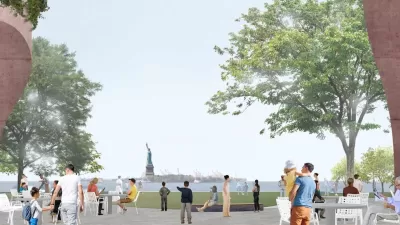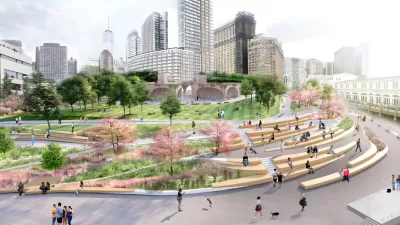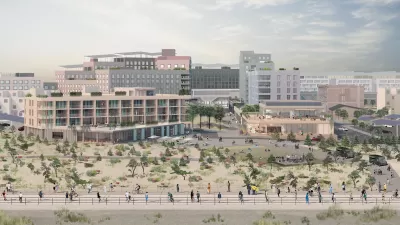New York City's 5.3 million square feet of “leftover” street space provides a prime opportunity to create public amenities and a more resilient city. Eric Tan and his colleagues at Gensler have created modular "Street Squares" to fill the void.
When Mayor Bloomberg announced the city's new $20 billion resiliency plan in June, "[the] idea of planting trees and vegetation (and drains) on New York City’s streets and rooftops to absorb and divert storm water slid past much of the media," notes Tan. "Perhaps it seemed too 'frilly' for adversaries the likes of Hurricane Sandy. But we think we should push the concept even further."
"What if some of the more generous central medians throughout New York’s street system were turned into green infrastructure: parklets that have been keenly designed to absorb and funnel storm water; generate solar electricity; and recycle food waste, which is another matter that Mayor Bloomberg is championing these days in the spirit of saving roughly $100 million a year by diverting organic residential waste from landfills."
Tan and his colleagues at Gensler New York developed NYC Street Squares, a "kit of parts" solution for maximizing the city's street-related filler space. "Our vision has the neighborhood voting via social media for the modules (bike racks, a community garden, children’s garden, bee farm, public shower, public sauna, lounge areas, electric car charging station, among them) that they want to see in their local street square."
FULL STORY: Redesigning New York's Hidden Public Spaces To Create A More Resilient City

Study: Maui’s Plan to Convert Vacation Rentals to Long-Term Housing Could Cause Nearly $1 Billion Economic Loss
The plan would reduce visitor accommodation by 25,% resulting in 1,900 jobs lost.

Alabama: Trump Terminates Settlements for Black Communities Harmed By Raw Sewage
Trump deemed the landmark civil rights agreement “illegal DEI and environmental justice policy.”

North Texas Transit Leaders Tout Benefits of TOD for Growing Region
At a summit focused on transit-oriented development, policymakers discussed how North Texas’ expanded light rail system can serve as a tool for economic growth.

Paris Bike Boom Leads to Steep Drop in Air Pollution
The French city’s air quality has improved dramatically in the past 20 years, coinciding with a growth in cycling.

Why Housing Costs More to Build in California Than in Texas
Hard costs like labor and materials combined with ‘soft’ costs such as permitting make building in the San Francisco Bay Area almost three times as costly as in Texas cities.

San Diego County Sees a Rise in Urban Coyotes
San Diego County experiences a rise in urban coyotes, as sightings become prevalent throughout its urban neighbourhoods and surrounding areas.
Urban Design for Planners 1: Software Tools
This six-course series explores essential urban design concepts using open source software and equips planners with the tools they need to participate fully in the urban design process.
Planning for Universal Design
Learn the tools for implementing Universal Design in planning regulations.
Smith Gee Studio
Alamo Area Metropolitan Planning Organization
City of Santa Clarita
Institute for Housing and Urban Development Studies (IHS)
City of Grandview
Harvard GSD Executive Education
Toledo-Lucas County Plan Commissions
Salt Lake City
NYU Wagner Graduate School of Public Service





























